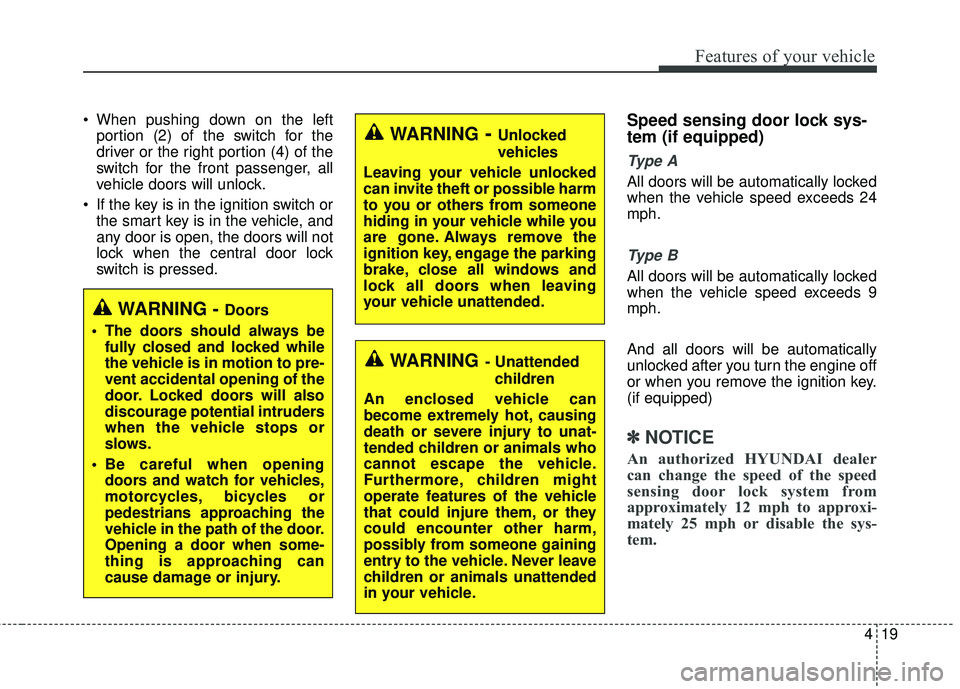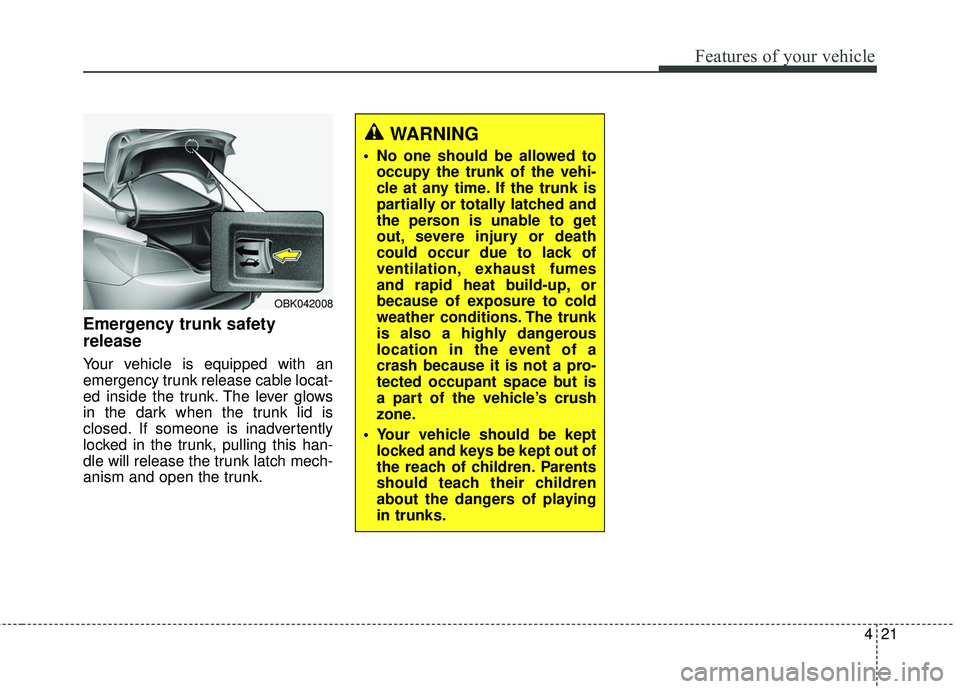2016 HYUNDAI GENESIS COUPE ULTIMATE child lock
[x] Cancel search: child lockPage 86 of 475

43
Features of your vehicle
Record your key number
The key code number is stamped or
printed on the key code tag attached
to the key set. Should you lose your
keys, this number will enable an
authorized HYUNDAI dealer to dupli-
cate the keys easily. Remove the key
code tag and store it in a safe place.
Also, record the key code number
and keep it in a safe place (not in the
vehicle).
Key operations
Used only to start the engine and
lock and unlock the door.
KEYS
WARNING -Ignition key
(Smart key)
Leaving children unattended in
a vehicle with the ignition key
(smart key) is dangerous even if
the key is not in the ignition
switch or the ENGINE
START/STOP button is ACC or
ON position. Children copy
adults and they could place the
key in the ignition switch or
press the ENGINE START/STOP
button. The ignition key (smart
key) would enable children to
operate power windows or
other controls, or even make
the vehicle move, which could
result in serious bodily injury or
even death. Never leave the
keys in your vehicle with unsu-
pervised children, when the
Engine is running.
WARNING
Use only HYUNDAI original
parts for the ignition key in your
vehicle. If an aftermarket key is
used, the ignition switch may
not return to ON after START. If
this happens, the starter will
continue to operate causing
damage to the starter motor
and possible fire due to exces-
sive current in the wiring.
OBK049113N
Page 102 of 475

419
Features of your vehicle
When pushing down on the leftportion (2) of the switch for the
driver or the right portion (4) of the
switch for the front passenger, all
vehicle doors will unlock.
If the key is in the ignition switch or the smart key is in the vehicle, and
any door is open, the doors will not
lock when the central door lock
switch is pressed.Speed sensing door lock sys-
tem (if equipped)
Ty p e A
All doors will be automatically locked
when the vehicle speed exceeds 24
mph.
Ty p e B
All doors will be automatically locked
when the vehicle speed exceeds 9
mph.
And all doors will be automatically
unlocked after you turn the engine off
or when you remove the ignition key.
(if equipped)
✽ ✽ NOTICE
An authorized HYUNDAI dealer
can change the speed of the speed
sensing door lock system from
approximately 12 mph to approxi-
mately 25 mph or disable the sys-
tem.
WARNING- Unlocked
vehicles
Leaving your vehicle unlocked
can invite theft or possible harm
to you or others from someone
hiding in your vehicle while you
are gone. Always remove the
ignition key, engage the parking
brake, close all windows and
lock all doors when leaving
your vehicle unattended.
WARNING- Unattended children
An enclosed vehicle can
become extremely hot, causing
death or severe injury to unat-
tended children or animals who
cannot escape the vehicle.
Furthermore, children might
operate features of the vehicle
that could injure them, or they
could encounter other harm,
possibly from someone gaining
entry to the vehicle. Never leave
children or animals unattended
in your vehicle.
WARNING - Doors
The doors should always be fully closed and locked while
the vehicle is in motion to pre-
vent accidental opening of the
door. Locked doors will also
discourage potential intruders
when the vehicle stops or
slows.
Be careful when opening doors and watch for vehicles,
motorcycles, bicycles or
pedestrians approaching the
vehicle in the path of the door.
Opening a door when some-
thing is approaching can
cause damage or injury.
Page 104 of 475

421
Features of your vehicle
Emergency trunk safety
release
Your vehicle is equipped with an
emergency trunk release cable locat-
ed inside the trunk. The lever glows
in the dark when the trunk lid is
closed. If someone is inadvertently
locked in the trunk, pulling this han-
dle will release the trunk latch mech-
anism and open the trunk.
OBK042008
WARNING
No one should be allowed tooccupy the trunk of the vehi-
cle at any time. If the trunk is
partially or totally latched and
the person is unable to get
out, severe injury or death
could occur due to lack of
ventilation, exhaust fumes
and rapid heat build-up, or
because of exposure to cold
weather conditions. The trunk
is also a highly dangerous
location in the event of a
crash because it is not a pro-
tected occupant space but is
a part of the vehicle’s crush
zone.
Your vehicle should be kept locked and keys be kept out of
the reach of children. Parents
should teach their children
about the dangers of playing
in trunks.
Page 108 of 475

425
Features of your vehicle
CAUTION
To prevent possible damageto the power window system,do not open or close two win-dows or more at the sametime. This will also ensure thelongevity of the fuse.
Never try to operate the main switch on the driver's doorand the individual door win-dow switch in opposing direc-tions at the same time. If thisis done, the window will stopand cannot be opened orclosed.
WARNING - Windows
Never leave the keys in your vehicle with unsupervised
children, when the Engine is
running.
NEVER leave any child unat- tended in the vehicle. Even
very young children may inad-
vertently cause the vehicle to
move, entangle themselves in
the windows, or otherwise
injure themselves or others.
Always double check to make sure all arms, hands, head
and other obstructions are
safely out of the way before
closing a window.
Do not allow children to play with the power windows. Keep
the driver’s door power win-
dow lock switch in the LOCK
position (depressed). Serious
injury can result from uninten-
tional window operation by
the child.
Do not extend a face or arms outside through the window
opening while driving.
Page 291 of 475

Before starting
Close and lock all doors.
Position the seat so that all con-trols are easily reached.
Adjust the inside and outside rearview mirrors.
Be sure that all lights work.
Check all gauges.
Check the operation of warning lights when the ignition switch is
turned to the ON position.
Release the parking brake and make sure the brake warning light
goes out.
For safe operation, be sure you are
familiar with your vehicle and its
equipment.
Driving your vehicle
45
WARNING
When you intend to park or stop the vehicle with the
engine on, be careful not to
depress the accelerator pedal
for a long period of time. It may
overheat the engine or exhaust
system and cause a fire.
When you make a sudden stop or turn the steering wheel rap-
idly, loose objects may drop on
the floor and it could interfere
with the operation of the foot
pedals, possibly causing an
accident. Keep all things in the
vehicle safely stored.
If you do not focus on driving, it may cause an accident. Be
careful when operating what
may disturb driving such as
audio or heater. It is the
responsibility of the driver to
always drive safely.
WARNING
All passengers must be proper-
ly belted whenever the vehicle
is moving. Refer to “Seat belts”
in section 3 for more informa-
tion on their proper use.
WARNING- Driving under
the influence of alcohol or
drugs
Drinking and driving is danger-
ous. Drunk driving is the num-
ber one contributor to the high-
way death toll each year. Even a
small amount of alcohol will
affect your reflexes, percep-
tions and judgment. Driving
while under the influence of
drugs is as dangerous or more
dangerous than driving drunk.
You are much more likely to
have a serious accident if you
drink or take drugs and drive.
If you are drinking or taking
drugs, don’t drive. Do not ride
with a driver who has been drink-
ing or taking drugs. Choose a
designated driver or call a cab.
WARNING
Always check the surrounding
areas near your vehicle for peo-
ple, especially children, before
putting a car into D (Drive) or R
(Reverse).
Page 306 of 475

519
Driving your vehicle
Transmission ranges
The indicator in the instrument cluster
displays the shift lever position when
the ignition switch is in the ON posi-
tion.
P (Park)
Always come to a complete stop
before shifting into P (Park). This posi-
tion locks the transmission and pre-
vents the drive wheels from rotating.R (Reverse)
Use this position to drive the vehicle
backward.
N (Neutral)
The wheels and transmission are not
engaged. The vehicle will roll freely
even on the slightest incline unless
the parking brake or service brakes
are applied.(Continued)
Before leaving the driver’s
seat, always make sure the
shift lever is in the P (Park)
position. Set the parking
brake fully, shut the engine off
and take the key with you.
Unexpected and sudden vehi-
cle movement can occur if
you do not follow these pre-
cautions in the order speci-
fied.
WARNING
Shifting into P (Park) while thevehicle is in motion will cause
the drive wheels to lock which
will cause you to lose control
of the vehicle.
Do not use the P (Park) posi- tion in place of the parking
brake. Always make sure the
shift lever is latched in the P
(Park) position and set the
parking brake fully.
Never leave a child unattend- ed in a vehicle.
(Continued)CAUTION
The transmission may be dam-aged if you shift into P (Park)while the vehicle is in motion.
CAUTION
Always come to a complete stopbefore shifting into or out of R(Reverse); you may damage thetransmission if you shift into Rwhile the vehicle is in motion,except as explained in “Rockingthe vehicle” in this section.
Page 467 of 475

I3
Index
Brake system··················\
··················\
············ ·5-25
Anti-lock brake system (ABS) ··················\
·······5-29
Electronic stability program (ESC) ··················\
··5-31
Parking brake ··················\
··················\
·········5-27
Power brakes ··················\
··················\
········· ·5-25
Brakes/clutch fluid ··················\
··················\
····· ·7-28
Bulb replacement ··················\
··················\
······· ·7-67
Bulb wattage ··················\
··················\
···············8-2
California perchlorate notice ··················\
·············7-86
Capacities (Lubricants) ··················\
··················\
···8-4
Care Exterior care ··················\
··················\
········· ·7-76
Interior care ··················\
··················\
·········· ·7-82
Tire care ··················\
··················\
·············· ·7-41
Cargo capacity ··················\
··················\
·········· ·5-53
Cargo weight ··················\
··················\
············ ·5-57
Center console storage ··················\
················· ·4-120
Central door lock switch ··················\
················· ·4-18
Certification label ··················\
··················\
······· ·5-55
Certification label ··················\
··················\
·········8-6
Chains Tire chains ··················\
··················\
············ ·5-49
Changing tires ··················\
··················\
··········· ·6-13
Checking tire inflation pressure ··················\
·········7-43 Child restraint system
··················\
··················\
·· ·3-27
Lower anchor ··················\
··················\
·········3-34
Passerger's seat ··················\
··················\
······ ·3-38
Seat belt ··················\
··················\
··············· ·3-30
Tether anchor system ··················\
················· ·3-32
Cigarette lighter ··················\
··················\
······· ·4-121
Climate control air filter ··················\
···········4-100, 112
Climate control air filter replacement ··················\
···7-33
Clock (Digital) ··················\
··················\
········· ·4-124
Collision sensors ··················\
··················\
·········3-55
Combined instrument, see instrument cluster ···········4-45
Compact spare tire replacement ··················\
·········7-46
Compass ··················\
··················\
················· ·4-37
Consumer information ··················\
··················\
··· ·8-8
Coolant ··················\
··················\
··················\
· ·7-25
Cooling fluid, see engine coolant ··················\
·······7-25
Crankcase emission control system ··················\
·····7-83
Cruise control system ··················\
··················\
·· ·5-37
Cup holder ··················\
··················\
··············4-120
Curtain air bag ··················\
··················\
·········· ·3-54
Dashboard illumination, see instrument panel illumination· ·4-46
Dashboard, see instrument cluster··················\
·······4-45
Daytime running light (DRL) ··················\
············4-83
Defogging (Windshield) ··················\
················ ·4-114
D
C